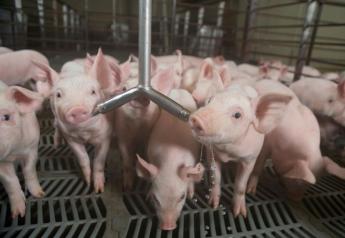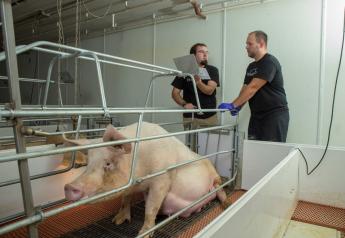There's More Than One Profitable Way to Feed Pigs

Researchers at Kansas State University have completed a large trial determine the feeding options that are best for pig producer’s profitability. The research is being presented as part of the 2017 K-State Swine Day.
Swine producers have a lot of ways to reach the same amount of profitability, depending on the cost of feed and the market value of finished pigs.
“When raising pigs, producers can have two goals, basically,” says Mariana Menegat, a K-State doctoral student in swine nutrition who led the research. “They may want to feed the lowest feed cost, or they may want to follow a program that gives them the best profitability.”
Menegat tested combinations of diets with 1,188 pigs in a commercial research barn. Over the course of 120 days, some pigs were fed lower-cost, lower amino acid diets, and others were fed a diet formulated with a higher-costing feed that included protein-rich amino acids.
“Sometimes when feeding the lowest feed cost, they may lose some performance. Producers know that they are giving up some growth performance, but they are paying less for feed,” she says. “On the other hand, they may be willing to pay more for feed, but they know that the pig is going to perform better and that they are going to get paid back in return.”
The researchers also tested the profitability of feeding diets in two or four phases, meaning the number of different diets that a pig gets during the grow-finish stages. In the swine industry, it’s known as phase feeding.
“Depending on the producer’s situation, we can manage with different strategies and get the same results in the income over feed costs,” Menegat says. “The idea is to get to the same profitability or the same result but using different strategies for different production systems.”
Throughout a given year, Menegat adds, producers could choose to change strategies when feed costs are lower, or when market prices for pigs are higher, for example.
“What it means is that the producer has some options,” says Mike Tokach, a university distinguished professor in the department of animal sciences and industry who oversaw Menegat’s work. “It comes back to what their personal endpoint and their personal goals are. If they really want maximum performance, they want to feed a little more amino acids. This research provides us with some good numbers to use for calculating economic returns under different scenarios.”
Tokach noted that Kansas State University has routinely published recommendations for including amino acids in swine diets. One purpose of this study was to assess whether the university’s current recommendations are still appropriate.
“As genetics improve, we need to keep re-assessing what the pigs’ needs are,” he says. “Some of the genetic companies just came out with new recommendations for their genetics, and their recommendations used to be lower than K-State’s recommendations for the same breeding lines, but now they are higher.
“One of the purposes of the trial was to compare what our standard recommendations were to these new amino acid recommendations.”
In the United States, pigs are fed as many as six different diets during various stages of growth. Menegat initially tested two- and four-phase feeding, but thinks that testing finishing diets in three phases or even one phase could produce similar profitability for producers.
Feeding fewer diets to pigs could ultimately save money in other areas, she says, such as in transportation and other related costs.







